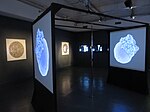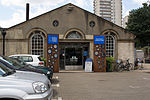Kew Palace

Kew Palace is a British royal palace within the grounds of Kew Gardens on the banks of the River Thames. Originally a large complex, few elements of it survive. Dating to 1631 but built atop the undercroft of an earlier building, the main survivor is known as the Dutch House. Its royal occupation lasted from around 1728 until 1818, with a final short-lived occupation in 1844. The Dutch House is Grade I listed, and open to visitors. It is cared for by an independent charity, Historic Royal Palaces, which receives no funding from the government or the Crown. Alongside the Dutch House is a part of its 18th-century service wing, whilst nearby are a former housekeeper's cottage, brewhouse and kitchen block – most of these buildings are private, though the kitchens are open to the public. These kitchens and Queen Charlotte's Cottage are also run by Historic Royal Palaces.
Excerpt from the Wikipedia article Kew Palace (License: CC BY-SA 3.0, Authors, Images).Kew Palace
Walpole Avenue, London Kew (London Borough of Richmond upon Thames)
Geographical coordinates (GPS) Address Website Nearby Places Show on map
Geographical coordinates (GPS)
| Latitude | Longitude |
|---|---|
| N 51.483888888889 ° | E -0.295 ° |
Address
Royal Botanic Gardens, Kew
Walpole Avenue
TW9 2DJ London, Kew (London Borough of Richmond upon Thames)
England, United Kingdom
Open on Google Maps









